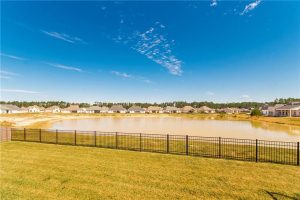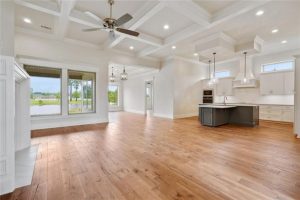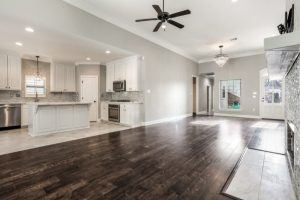Madisonville Gets a Grant For Park Improvements

Find out about the latest news in Madisonville, Louisiana as well as St. Tammany Parish. We will keep you “tuned in” to all of the information about Southeast Louisiana as well as the real estate industry in general. Many new home buyers are concerned about the market, mortgage information, and builder trends. We plan on keeping you as up to date as possible on these and many more topics. There is a lot going on in the Greater New Orleans area, so you will have plenty to read!

Good news for the housing market, the new home building is starting to pick back up but builders are still frustrated. This fall we have seen an uptick in new home building even with the slower demand from new home buyers. Builder sentiment is still down though due to things like the high cost of building materials.
According to the US Census Bureau, August home starts for new home construction rose 12.2% from the previous month. This is still 1% down from August 2021 just a year ago. The home starts are still trying to catch up this fall from the big drop that was seen this spring. The housing starts have been holding steady up until about a month ago when they began to increase.
The increase is a plus for the housing market due to the low inventory that has disrupted the market for the past two years. The rise in home prices and bidding wars are part of the direct outcome of this shortage. ” The latest month’s increase is implying that builders still see profit opportunities even as they concede on prices,” said Lawrence Yun, chief economist at the National Association of Realtors.
Multi-family projects have seen the biggest gain which jumped 30% from July, single-family homes only rose 3.4% from a month ago. Even with these increases, builders are still shy about being too optimistic of what the future holds. Building permits dropped 10% from the beginning of the summer and were down 14.4% from the same time last year. Surveys are still showing that builder confidence is still falling.
This fall is partly to be blamed on higher mortgage rates, supply chain problems and high home prices. “Buyer traffic is weak in many markets as more consumers remain on the sidelines due to high mortgage rates and home prices that are putting a new home purchase out of financial reach for many households,” said Jerry Konter, NAHB Chairman.
The National Association of Home Builders reports show that builder sentiment has gone down every month since 2022 and shows no signs of rising anytime soon. “Builders continue to grapple with elevated construction costs and an aggressive monetary policy from the Federal Reserve that helped push mortgage rates above 6% last week, the highest level since 2008,” according to Robert Dietz, NAHB Chief Economist.
“In this soft market, more than half of the builders in our survey reported using incentives to bolster sales, including mortgage rate buy downs, free amenities and price reductions,” said Dietz.
This is still not pushing home buyers back into the market. The study also shows that the cycle of homeowners moving up from a starter home is stalling due to the high prices and rising mortgage rates. First-time home buyers are also stalling and choosing to rent instead.
“Many potential ‘move-up’ buyers who would be likely candidates for high-priced new construction homes may also be weighing the benefits of remaining in their current home, where they likely have a mortgage rate less than half of today’s going rate – all factors that are contributing to a decline in housing mobility,’ said Kelly Mangold of RCLCO Real Estate Consulting.
The huge increase in multi-family buildings is due to the record high rents around the country. “Apartment demand has been strong, with rents rising at a historically high pace. Those consumers unable to qualify for a mortgage at higher interest rates are renewing their rental leases. Job creation is also boosting the rental demand,” stated Yun.

July 2022 saw the third consecutive month of home sale growth. This is just a sign that the housing market is starting to slow down due to rising rates.
It is reported that the number of active listings is up 30.7% from July 2021. This was part of the Monthly Housing Trends report from Realtor.com. The average rate on a 30-year fixed mortgage rate rose 6% this summer but has dipped some this fall.
“The U.S. housing market continues to move oward more evenly balanced supply and demand compared to the 2021 frenzy,” said Danielle Hale, the chief economist at Realtor.com. “Our July data shows elevated mortgage rates left many buyers tightening their budgets and sellers responding with price reductions, while home shoppers who kept searching saw more available options.”
The Federal Reserve is moving at the fastest pace seen in thirty years to tighted policy. The reason is to cool consumer demand and bring the housing market back under control. The policymakers are approving two back-to-back 75 basis point rates hikes. There will be another big increase depending on the upcoming economic data.
If you are looking to buy a home, choose a local Realtor who can help you with the rise in borrowing costs and home prices. Redfin has reported that the share of sale agreements on existing homes canceled was around 15% of the homes that went under contract. This has been the highest since we have seen pre-pandemic.
Reports show that the market for potential existing home sales were down still from the pandemic. June 2022 showed an estimate of 5.47 million at a seasonably adjusted annualized rate of 13.1% which was lower than just one year ago and 2.5% lower than just last month. The housing market is still strong, however still down compated to before the pandemic.
The factors that drive the existing home sales market have changed. The housing market is still trying to adjust to a post-pandemic norm coupled with higher mortgage rates and high home prices. The current rise in home prices is not the norm. June 2022 saw sales decreased by 823,000 compared to June of 2021. There are many fundmentals that are causing the slow down. Declining House-Buying Power is one which is basically how much home a buyer can afford. Factors that are looked at include household income and the current 30-year fixed mortgage rate. Another is tighter credit standards which means when lending standards are tight, then it is harder for a potential buyer to become qualified. When it is harder for a buyer to get a loan, then homes are not going to sell. The last catalyst is increasing tenure. This year it is reported that tenure length has increase from 10.4 years to 10.6 years. This has been driven by low mortgage rates and potential sellers staying put.
On the otherhand there are several fundamentals that are boosting the housing market potential. The biggest we have seen is rising house prices. When home prices rise, the home owner’s equity becomes stronger. Another factor is rising household formation which means the more households formed, the higher the demand for home inventory. Lastly, there is more new home supply. Seller will not want to sell if there is nothing for them to buy.
The housing market potential for existing-home sales is down compared to last year because of the factors mentioned above but it is still a good time to purchase a home. If you are in the market for a home, find a local sales agent who can help you navigate the current housing market.
In order to find out the potential home sales, existing-home sales are measured which include single-family, townhomes, condos and co-ops. These are taken on a seasonally adjusted annualized rate that is factored by looking at the historical relationship between existing home sales and the country’s population, demographics, homeowner tenure, and pricing trends. This is all done through The Potential Home Sales model which is published by the National Association of Realtors.
Like everything else, the commercial real estate business has seen changes due to the pandemic in the past two years. Add another catalyst to the mix, global inflation and we have a whole new ball game. This fall we have seen a change from the previous fall in interest rates.
Commercial real estate investors and lenders are viewing underwriting in a different perspective than times past. This is due to how investors are working with debt. Currently, the cost of debt is higher making the old on commercial real estate weaker than it was six to twelve months ago.
The Commercial real estate industry is hesitant because this certain rate environment has not shown up in a long time. The competitiveness of the market has also slowed down because a lot of the pent up demand that was seen after the worst of the pandemic is now gone.
Buyers and sellers are working at a slower pace than just six months ago. Transactions are being thought through more with the change in interest rates and capital markets. In fact, many commercial real estate lenders are stepping away altogether.
Inflation has also slowed things down. Labor cost and material cost have seen an extreme rise in costs . This has a big impact because when both lenders and investors look at future cash flow, these higher costs can dampen the profit margin. The Southeast market has actually seen double-digit rent growth already from this time last year.
When it comes to international affairs, interest rate hikes and the potential of a recession the capital markets are uncertain causing an upset in capital markets. This has become a challenge for lenders and their ability to lend.
There has also been a change in the demand for many lending products. Investors are looking for more long-term and fixed-rate lending products. The drastic shift can be blamed on the fast-rising interest rates.
As for the state of the current commercial real estate lending market, lenders still have maintained underwriting standards and the leverage has not gone completely unhinged. Structures are still sturdy and there is still a lot of equity capital in deals today. Last year saw a record year due to the floodgates opening after the pandemic restrictions. We are in a more measured environment but that does not mean it is not an active market.